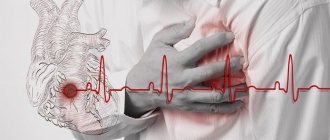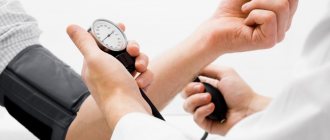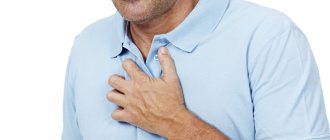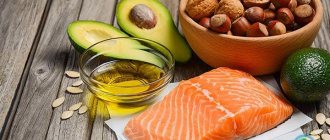Extrasystole: why you can’t trust information on the Internet regarding its symptoms
Often people who feel the symptoms of extrasystole make a serious mistake: instead of immediately contacting a specialist (cardiologist, psychologist, psychotherapist), they start looking for information on the Internet, trying to find out what extrasystole , what is happening to them and how dangerous it is. They browse a huge number of medical sites and forums, receiving a barrage of completely unnecessary and often completely harmful information - and thereby only worsen their condition. So reading medical articles, communicating on forums and communities more often do harm than good. Why?
Firstly, the symptoms of extrasystole are discussed by unknown people, citing unreliable sources, many of which were either written by amateurs or are long outdated.
Secondly, websites and forums are often written by illiterate people who, although not on purpose, misinform readers.
Thirdly, people who really have heart problems come there: organic lesions, other forms of arrhythmia, etc. They communicate with people whose extrasystole is purely functional in nature, that is, it is just a psychological problem, and there are no pathological changes in the heart. As a result of such communication, a person with symptoms of extrasystole increases anxiety and fears of dying from heart disease, when in fact his heart is absolutely healthy.
Say no to forums and medical sites
Receiving a bunch of unnecessary and useless information, a person begins to limit himself physically, he develops a fear of extrasystole and develops cardiophobia. But if a person really wants to get rid of the fear of extrasystole , which is actually safe, he needs to avoid visiting any medical sites. Everyone. Even those where there are good cardiologists who confirm that extrasystole is, in principle, safe. It is enough to download a couple of articles where good cardiologists say that it is safe, and that’s all. And constantly visiting medical sites will lead to a person misinterpreting the information that is presented there, because he is not a cardiologist.
The same applies to forums dedicated to VSD. If you go to any of them and find a topic about extrasystole , you can read a lot of stories written by different people who are far from medicine. Moreover, all these stories are filled with complaints and do not contain any valuable information. Sometimes people on such forums write sheer nonsense, and a person, instead of finding ways to solve his problem, begins to get confused and scared.
Sudden vegetative-vascular attack
The so-called “vegetative-vascular crises”, which in practice occur like panic attacks, deserve special attention. The sudden onset of feelings of fear and anxiety is accompanied by severe somatic symptoms (palpitations, inability to breathe). They are extremely difficult for patients to tolerate and lead to complete social maladjustment. Moreover, a person is constantly in painful anticipation of a second attack.
In some patients, the attack appears suddenly. Others note a clear relationship with potentially threatening or stressful situations. This could be being in society, a cramped room or space, exciting news, etc.
In addition to severe anxiety and fear, the patient experiences palpitations, a lump in the throat, a feeling of lack of air and the inability to breathe. Choking, dizziness, increased heart rate, as well as disorientation in space and time lead to a feeling of fear of death. A panic attack often causes an ambulance to be called.
The problem is not in the extrasystoles themselves, but in the attitude towards them
of extrasystole during the day . Of course, this scared him. The main thing here is to understand that if a person does not have organic damage to the heart muscle, but has neurosis or some kind of exhaustion, then the problem is not in extrasystoles. Because there are people who have 30 thousand extrasystoles a day, but they don’t feel them and live normally. Moreover, almost all people have extrasystoles; they can be detected using a holder - an electrocardiogram device that reads information throughout the day. So the problem is not in the extrasystole , but in the attitude towards it.
Diagnostics
The diagnostic program for suspected VSD is to exclude pathology of internal organs, the cervical spine, as well as impaired blood supply to the brain. The scope of the diagnostic program is determined by the attending physician based on the patient’s complaints. As a rule, a simple laboratory and instrumental examination is sufficient. For example, in case of cardiac complaints, an ECG, ultrasound of the heart, daily monitoring of pressure and heart rhythm, and stress tests are performed. For complaints of dizziness and darkening of the eyes, a duplex of the vessels of the head and neck, or an MRI of the brain in vascular mode. In many cases, a consultation with a psychotherapist is recommended, especially if no violations of the internal organs or the central or peripheral nervous system are detected.
Osteopathic diagnosis plays an important role. It allows you to identify those disorders that are “not visible” during instrumental examination. Often, the patient is referred to a psychotherapist, while the cause is quite “tangible” and can be perfectly treated with osteopathy. Diagnostics is based on the fine sensitivity of the hands of an osteopath and allows you to identify those areas of the body in which tissues are “tight,” move poorly, or affect other areas of the body, disrupting their normal function.
For example, with symptoms such as:
- dizziness, weakness;
- panic attacks;
- difficulty breathing;
- chest pain;
- chronic pain;
- heartbeat;
- high blood pressure;
- arterial hypotension;
- stomach ache.
What cardiologists write about extrasystole
Cardiologist Eduard Romanovich Guglin:
“ Extrasystole is the most common and most harmless form of heart rhythm disturbance. Extrasystole is a manifestation of increased excitability of the heart muscle. Most often these are functional changes, but we do not find organic changes. And the heart, despite sometimes many years of extrasystole, remains healthy. This type of arrhythmia does not shorten life or increase the risk of other diseases or death. She's harmless enough. And the drugs that we use with greater or less success to suppress it, to reduce its frequency, are themselves quite toxic compounds.
As a result of large studies, it has been repeatedly established that suppressing extrasystole with antiarrhythmic drugs worsens, rather than improves, health, and therefore we usually try to persuade patients not to treat extrasystole. The whole problem is that in the normal state of the central nervous system they do not reach consciousness, do not rise above the subcortex and are not perceived by the brain. And with increased excitability, with various neuroses, these signals break through the barrier of the subcortical filter, and are perceived at the level of consciousness as something extra disturbing. With increased nervous sensitivity, they are perceived as a disorder, pathology, and frighten, alarm, and interfere with life.
Continuation
You just need to believe that extrasystole is not a harbinger of any organic heart disease, does not shorten life and, as a rule, does not require treatment. However, if it spoils life and reduces its quality, it can be treated with sedatives and sedatives. They increase the sensitivity threshold, transfer this reaction back to the subcortical level, reducing the degree of their perception by consciousness. They improve the tolerance of interruptions, making them less noticeable and less disturbing.
Let me give you an example: an athlete with ventricular extrasystoles who does not have organic heart disease has no risk of developing cardiovascular diseases. In one of the recent publications, ventricular extrasystoles of 2000 or more per day were determined in 70 athletes. They were suspended from physical activity for 3 months. In 16 of them, PVCs disappeared completely, in 34 PVCs decreased to 500 or less, in 20 there were no changes. All were allowed to compete, and over 8 years of observation, no one had any cardiovascular diseases.
Previously, it was assumed that high gradations of extrasystoles (class 3-5) were the most dangerous. However, further studies found that the clinical and prognostic significance of extrasystole (and parasystole) is almost entirely determined by the nature of the underlying disease, the degree of organic damage to the heart and the functional state of the myocardium. In persons without signs of myocardial damage, with normal contractile function of the left ventricle (ejection fraction), more than 50 extrasystoles , including unstable episodes of unstable ventricular tachycardia, even continuously reducing tachycardia, do not affect the prognosis and do not pose a threat to life.”
Kinds
There is still no unified classification of vegetative-vascular dystonia that would take into account the diversity of its manifestations. In medical practice, VSD is most often divided into several types:
- vagotonic – the clinical picture is due to the predominance of the parasympathetic department over the sympathetic one (low blood pressure, chills, dizziness, lightheadedness, “lump in the throat” and others);
- sympathicotonic - symptoms are associated with hyperfunction of the sympathetic department (increased blood pressure, rapid heartbeat, feeling of heat);
- mixed - both types of symptoms may be present in the clinical picture.
Depending on the mechanism of development, the syndrome is divided into two types: primary and secondary. The primary form of VSD occurs independently, the secondary form occurs against the background of existing diseases of various localizations.
Vegetative-vascular dystonia is also divided into subtypes depending on organ symptoms. Here are several clinical variants of VSD:
- changes in the cardiovascular system;
- disruption of the gastrointestinal tract;
- psychoemotional and nervous disorders;
- changes in the functioning of the respiratory system.
The most common VSD involves the cardiovascular system. This type of syndrome has its own name - neurocirculatory dystonia. It is divided into several clinical subtypes.
| Hypertensive | Hypotonic | Cardiac |
| Characterized by increases in systolic blood pressure, palpitations and interruptions in heart function. Combined with other manifestations of sympathicotonia (for example, hot flashes, sweating). | It is characterized by lowering blood pressure and slowing heart rate. Other symptoms include signs of vagotonia (dizziness, fainting, and others). | The main complaint is pain in the heart area of varying nature and severity. Most often, the pain is stabbing and occurs against the background of emotional stress. |
Any of the listed variants of vegetative-vascular dystonia can be of three degrees of severity: mild, moderate or severe. The severity of the condition is assessed based on the client’s complaints and the severity of clinical manifestations.
The course of VSD can be permanent (constant) or paroxysmal (paroxysmal). The first variant of the syndrome is spoken of in cases where the symptoms bother you almost every day and are mild or moderate. A vegetative-vascular attack begins suddenly against the background of the patient’s relative health and is accompanied by a significant deterioration in the general condition. As a rule, an attack is provoked by overwork or psycho-emotional stress.
Clinical manifestations
The whole variety of symptoms of autonomic dysfunction can be divided into several groups. In this case, the organ localization of manifestations of vegetative-vascular dystonia is taken into account.
Cardiovascular manifestations
Cardiovascular symptoms in adults and children are very common with VSD. The main ones are cardialgia (pain in the heart) and various rhythm disturbances. Most often, heart pain appears suddenly against the background of previous emotional stress, less often they are observed at rest. They have a stabbing character. Patients themselves usually describe the pain syndrome with the phrase “stabbing like needles,” pointing to the area of the heart.
The duration of pain varies. For some it is a single tingling sensation, for others it is a long-term discomfort. The pain can also radiate to the shoulder girdle, left arm or shoulder blade, and less commonly to the right half of the body. Such symptoms sometimes cause suspicion among doctors due to the similarity of clinical manifestations with coronary heart disease, in particular with angina pectoris.
Rhythm disturbances are represented by its slowdown or acceleration (brady- and tachycardia). Bradycardia is usually not felt by the patient and is detected during examination. An increased heart rate may be perceived as palpitations. Less common are extrasystoles, which are felt as a “fading” of the heart.
This group of symptoms also includes an increase or decrease in blood pressure (hypertensive and hypotonic type of syndrome). The vascular manifestations of VSD are diverse. They are mainly represented by chilliness and freezing, coldness of the extremities, and pallor of the skin.
The most pronounced cardiovascular signs of vegetative-vascular dystonia are in patients suffering from paroxysms. During an attack, the symptoms sharply worsen, and in addition to them, uncontrollable fear, a feeling of lack of air, and others appear.
Gastrointestinal manifestations
Symptoms of VSD from the digestive organs are varied. They can be combined into two large groups: dyspepsia and irritable bowel syndrome. In the first case, the patient's complaints are presented as follows:
- pain in the projection of the stomach or esophagus of varying intensity, not having a clear relationship with food intake;
- belching air;
- feeling of fullness in the stomach, distension;
- flatulence;
- nausea;
- unpleasant taste in the mouth, often metallic or bitter;
- tendency to diarrhea or constipation.
Such symptoms are similar to manifestations of a peptic ulcer, but when examining the patient, no signs are found. The listed complaints bother patients for a long time, and drug therapy does not provide a lasting effect. Disorders of the gastrointestinal tract often cause a decrease in appetite and body weight.
Another type of disorder with autonomic dystonia is irritable bowel syndrome. Its main manifestations are stool upset and widespread abdominal pain. At the same time, the patient’s appetite does not suffer, and body weight remains the same. Painful sensations can be long-lasting and aching, or acute, paroxysmal (like spasms). Stool disorders are represented by diarrhea (defecation three times a day or more often) or constipation (stool less than three times a week).
Respiratory symptoms
The main respiratory symptoms of VSD are represented by neurogenic respiratory disorders. The respiratory system, although considered autonomous, is still closely connected with the emotional state. Anxiety and low mood play a special role here.
Under the influence of a psychogenic factor, the rhythm of normal breathing is disrupted. It becomes faster and deeper. As a result, hyperventilation develops, which can lead to biochemical changes. A patient with respiratory disorders experiences hypocapnia (lack of CO2 in the blood) and respiratory alkalosis (alkalization of the blood). These shifts can lead to pain and other sensory disturbances, which again triggers breathing failure.
Respiratory disorders may include the following:
- labored breathing;
- feeling of lack of air;
- violation of the frequency and depth of breathing;
- equivalents of hyperventilation (frequent sighs, coughing, yawning).
Respiratory symptoms of VSD are sometimes referred to as “empty breath.” The patient's main complaints are dissatisfaction with inhalation and a feeling of lack of air. The constant feeling of lack of air is manifested not only by deep breaths. Patients do not tolerate hot weather and prolonged stay indoors.
Respiratory disorders are more pronounced in crowded places or during stressful situations. In the paroxysmal form of VSD, respiratory disorders are of the nature of a hyperventilation crisis and are expressed to a significant extent.
Nervous and psychoemotional disorders
This group of symptoms is regarded by most doctors as the main one. Mental and emotional disorders in VSD are most pronounced. They can be represented as follows:
- increased anxiety and constant nervousness;
- lability (swings) of mood, a tendency to decrease;
- various types of phobias (fears), especially social ones;
- panic disorders;
- sleep disorders;
- obsessive thoughts and actions (constant hand washing, checking things);
- non-acceptance of oneself;
- loss of interests and desire to do anything;
- inability to enjoy or take pleasure in anything.
Neurological symptoms also include fainting. They are more often observed in adolescents and young adults. The mechanism of their development is associated with a short-term decrease in cerebral circulation. Fainting can last from a few seconds to several minutes. It is not accompanied by convulsions, and after fainting there may be general weakness and a feeling of weakness.
In most patients, true neurological disorders (primary headaches, neurogenic fainting) or mental illnesses are hidden under the “mask” of VSD. The fact is that the diagnosis of VSD is only a statement of the fact that the patient has some somatic symptoms. The root cause of these complaints remains unknown to general practitioners.
Somatic manifestations of VSD in psychiatry are almost always considered as a consequence of mental disorders, especially the anxiety spectrum. The range of mental disorders that have symptoms of vegetative-vascular dystonia includes depression, anxiety-phobic disorders, mania and neurotic-type syndromes.
Other symptoms
VSD can also manifest itself as thermoregulation disorders. A number of patients may experience a rise in temperature due to emotional stress, more often in the morning. This may be accompanied by a feeling of heat and profuse sweating. Temperature rises are more often observed in the autumn-winter period.
With the vagotonic type of VSD, patients blush easily in stressful situations. The skin has a cyanotic (blue) color, moist and cold. Upon closer examination, a vascular pattern is revealed, giving the skin a marbling appearance.
Vagotonia is also characterized by excessive greasiness of the skin and a tendency to acne. Sympathicotonia, on the contrary, is characterized by dry skin and a tendency to peel. Sweating in patients is scanty.
And here is what antiarrhythmologist Alexander Ivanovich Korzun says about extrasystole:
“ extrasystole and does not require treatment. To their misfortune, someone feels these extrasystoles. In such cases, it is optimal to distract yourself with life: friends, family, children, work, hobbies, etc. If you can’t get distracted, then you need the help of a psychotherapist.”
According to these experienced doctors, it turns out that it does not matter what kind of extrasystoles a person has: ventricular, supraventricular, or preventricular. It is important that if he does not have organic heart disease, then the problem of extrasystole can be successfully solved with the help of a psychotherapist. There are also good experts who say: before there was no holder, and all people lived peacefully. Now the problem arises due to the fact that a person begins to feel extrasystoles, and the holder records them, thus creating a problem. Psychotherapy helps here, that is, increasing stress resistance.
True, the same Korzun also says that extrasystole is often a consequence of problems of the gastrointestinal tract. And gastrointestinal diseases primarily occur in people suffering from nervous disorders. Therefore, if a person really has problems with the gastrointestinal tract (gastritis, ulcers, reflux esophagitis), then he really needs to first treat the stomach in order to reduce the severity and manifestations of extrasystoles.
About drugs
Often, if a person goes to a cardiologist, he is prescribed antiarrhythmic drugs: Citalex, Propanorm, etc. Here, everyone takes responsibility for themselves whether they will take these medications or not, but reliable sources say that these drugs worsen a person’s condition. Therefore, you just need to keep in mind that with a healthy heart, extrasystole does not cause any problems. Problems begin when a person begins to obsess over them, when he begins to struggle with them, when he begins to read what he does not need to read and interpret it incorrectly.
With all the trust and respect for Eduard Guglin or Alexander Korzun, by constantly visiting their sites, a person only harms himself because he comes across some messages that he does not need. He begins to read about other types of arrhythmia, about other problems, without understanding the connection between them and taking individual phrases out of context.
Simply because an ordinary person who has problems and is looking for solutions to them is not a qualified cardiologist.
Therefore, if a person has such a symptom of vegetative-vascular dystonia as extrasystole , and he really wants to get rid of this problem, then, first of all, it is necessary to exclude communication on this topic, stop visiting medical sites and begin to move along the path of getting rid of neurosis, from anxiety disorder, from your internal tension, which leads to these problems. And then the extrasystole will gradually go away.
Of course, this article is intended for a rather narrow audience: some have extrasystole , others do not. If you don't have one, you're lucky: you don't even have to think that you might have one. But if it does appear, you are doubly lucky, because you will know that this is a completely harmless form of arrhythmia.








